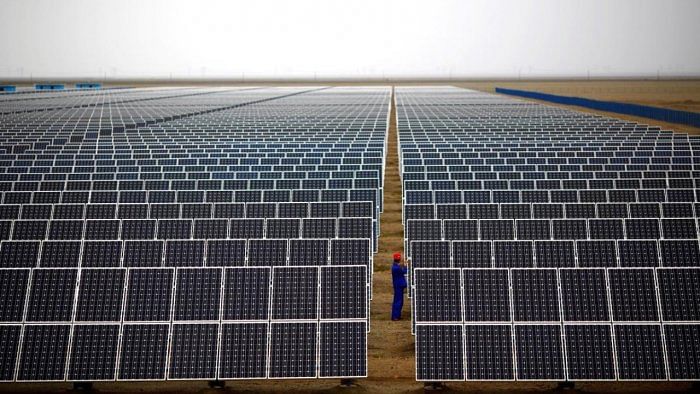
As much as 85% of India’s renewable energy (RE) projects, especially solar power plants, sit on agriculture and ecologically sensitive lands.
According to a study, this can adversely impact local communities, food security, and biodiversity and even cause greenhouse gas emissions that reduce the benefit of alternative energy sources on climate.
According to the study – ‘An artificial intelligence dataset for solar energy locations in India,’ published in the journal Nature - conducted by The Nature Conservancy (TNC-India) and Microsoft, the solar and wind projects, generate 45 Gigawatts (GW) of power are set up on 67.6% of agriculture land (800 sq km) and 18.7% on ecologically sensitive lands (280 sq km).
Of the total agricultural land under solar power projects, 38.6% has the potential to cultivate seasonal crops.
The natural habitat where these projects have come up includes evergreen, deciduous, littoral swamp forests and scrubland.
Shivaprakash K N, senior scientist at TNC-India, and one of the study’s co-authors says that compared to thermal power plants, solar power parks require eight to 12 times more land to generate the same amount of energy.
“India has committed to generating 500 GW of RE by 2030. Of the total RE, India intends to generate 420 GW of power from solar and wind projects. Given the huge land footprints required to achieve the ambitious RE goals, our initial study indicates this could lead to environmental and socio-ecological risks, if not planned carefully,” he said.
While there is no dispute among experts and government officials regarding the necessity to invest hugely in renewable energy, what the report suggests is a careful study of the environmental and other impacts that these ‘green projects’ can cause.
‘Use wasteland’
The study suggests using more degraded wasteland and converted land, which currently generates approximately 4.34 GW of energy.
“We need to use the space available over canals, reservoirs, highways, coal mines and more importantly, rooftops to generate solar power,” he says. With proper planning, India can generate 1,789 GW of power, nearly four times the 2030 target by utilising converted land, Shivaprakash said.
He said, since 2012, India is witnessing resistance among local people in parting away dry land for renewable power projects as it reduces agricultural land and access to common land resources.
“Even in Karnataka’s Pavagada (Tumakuru dist), we are witnessing opposition to the solar project as it is affecting the livelihood of landless and pastoral communities,” he said.
Official’s take
Amaranath N, chief executive officer of Karnataka Solar Power Development Corporation Limited, said while efforts are on to set up floating solar panels on canals and other water bodies, Karnataka, which generates nearly 50% of its energy needs through renewable sources, is not using fertile land for cultivation.
“Including at Pavagada solar park, the world’s third largest photovoltaic solar park, the government has not purchased land but has taken it on lease. Farmers voluntarily leased out nearly 13,000 acres of land at Rs 22,000 per acre per year. They gave these lands as they were unable to generate even that revenue per year,” he said and added it is an unfounded fear of degeneration of land due to solar projects.
He said research and development is taking place to minimise land use for the generation of RE.
Amaranath said as per the RE Act-2022, the state intends to generate 5 GW of alternative sources of power by 2030, out of which solar will have lion’s share of 50%, wind (20%), biomass and mini-hydel project (10%).